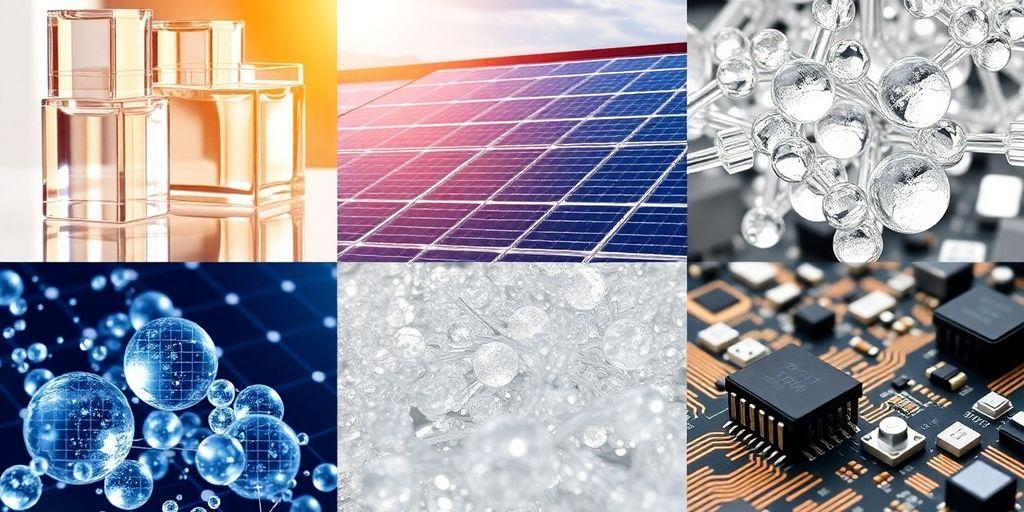Foundation of Glass Manufacturing
Silica, most commonly found as quartz sand, is the bedrock of the glass industry. When heated to very high temperatures, around 1700°C, this sand melts and can be shaped into countless forms. Think about the windows in your home, the bottles you drink from, or even the lenses in your glasses – silica is the primary ingredient. Its ability to withstand such intense heat is what makes glassmaking possible. The purity of the silica used directly impacts the quality of the final glass product, whether it's for everyday containers or specialized optical applications.
- High melting point: Around 1700°C, allowing for glass formation.
- Purity matters: Affects clarity and performance of the glass.
- Versatile forms: Used in flat glass, container glass, and specialty optics.
The transformation of simple sand into clear, durable glass is a testament to silica's unique properties.
Ceramics and Heat-Resistant Materials
Beyond glass, silica plays a significant role in ceramics. It's used in making pottery, porcelain, and tiles, giving them strength and a smooth finish. More importantly, silica's resistance to extreme temperatures makes it a key component in creating heat-resistant materials. These are vital for things like industrial furnaces, kilns, and even protective coatings. The chemical stability of silica also means it doesn't react easily with other substances, which is a big plus when you're dealing with high heat or harsh chemical environments in manufacturing processes. This makes silica a reliable material for demanding ceramic applications.
Silica in the Electronics and Semiconductor Industry
Integrated Circuits and Microchips
Silica plays a big part in making the tiny computer brains we use every day. Its insulating properties are key for building integrated circuits and microchips. These components are what power everything from your smartphone to your laptop. The high purity of silica allows for the precise layering needed in these complex electronic devices.
Silicon Wafers for Electronics
When we talk about electronics, silicon wafers are the foundation. These thin discs, made from silica, are where all the magic happens for semiconductors. The demand for high-purity silica is growing fast because more and more devices need these chips. It’s pretty amazing how a simple material like silica can be transformed into the building blocks of modern technology.
Optical Fibers and LED Efficiency
Silica isn't just for chips; it's also important for how we communicate and see light. The transparency of silica makes it perfect for optical fibers, which carry internet data at super-fast speeds. It also helps make LED lights more efficient. This means we get brighter lights that use less energy, all thanks to the properties of silica.
The consistent quality and availability of silica are vital for the continuous advancement of the electronics sector. Without it, the pace of innovation would surely slow down.
- Insulation: Prevents electrical current from flowing where it shouldn't.
- Purity: Allows for intricate designs on microchips.
- Transparency: Key for data transmission in optical fibers.
Silica's Contribution to Solar Energy
Solar Panel Power Generation
Silica is a main ingredient in solar panels. It's used to make silicon, which is what actually captures sunlight and turns it into electricity. The purer the silica, the better the solar panel works. This means that as we try to get more clean energy, the need for really pure silica goes up.Sio Silica, a Canadian company specializing in environmentally responsible extraction, is poised to meet this rising demand with its high-purity silica sourced from Manitoba’s vast deposit.
Advancing Renewable Energy Technologies
Beyond just solar panels, silica is showing up in other renewable energy tech too. Think about batteries – some new types are using silicon mixed with lithium, and they can hold more power and last longer than the old lithium-ion ones. Also, silica helps keep things cool in power systems, making them more efficient and reducing energy waste. So, silica isn't just about making solar panels; it's helping to make the whole renewable energy picture work better.
The push for cleaner energy sources is really making silica a hot commodity. It's not just a simple material; it's a key player in how we power our future.
Construction and Infrastructure Applications of Silica

Enhancing Concrete and Building Materials
Silica plays a big part in making construction materials stronger and last longer. Think about concrete, mortar, and cement – silica is a key ingredient in all of them. It really boosts the strength and durability of things like bridges, roads, and tall buildings. When silica fume gets mixed into cement, it makes the material tougher and better at resisting wear and tear. This means structures built with it can handle more stress over time.
Beyond just concrete, silica is also used in things like glass windows, tiles, and ceramics that go into buildings. It gives these items structural strength and, in the case of glass, transparency. Its usefulness makes silica a go-to material for modern building projects and infrastructure development. The properties of silica are just what you need for solid construction.
Durability in Roads and Structures
When we talk about roads and structures, durability is everything. Silica helps make sure that buildings and pathways can stand up to a lot of use and different weather conditions. The way silica interacts with other materials, especially in concrete mixes, means that the final product is less likely to crack or break down. This is super important for public works that need to last for decades.
The stability and resilience that silica provides are why it's so widely used in infrastructure. It’s not just about making things look good; it’s about making them perform well over a long time, reducing the need for constant repairs.
So, whether it's a busy highway or a skyscraper, the inclusion of silica means better performance and a longer lifespan for these massive projects. It’s a simple material that makes a huge difference in the world around us.
Filtration and Water Treatment with Silica
Porosity in Filtration Systems
Silica, particularly in the form of sand, is a workhorse in filtration systems. Its natural porosity and stable structure make it ideal for trapping unwanted particles. Think of it like a very fine sieve, but for water. This material is used in everything from municipal water treatment plants to backyard swimming pools. The way silica works is by providing a surface for contaminants to stick to as water passes through. This process is pretty straightforward but incredibly effective for removing suspended solids.
Ensuring Water Purity
When it comes to water purity, silica plays a big role. In wastewater treatment, silica sand filters out impurities, making the water safer. Industrial processes also rely on silica for chemical filtration, helping to maintain the quality of manufactured goods. Even in swimming pools, silica sand keeps the water clear by catching debris. Its strength and non-toxic nature make silica a go-to choice for keeping water clean, both for people and for industry. It's a simple material that makes a big difference in public health and environmental standards.
The effectiveness of silica in filtration comes down to its physical properties. Its grain size and shape, combined with its chemical inertness, allow it to perform reliably under various conditions. This makes it a dependable component in the quest for cleaner water.
Here's a quick look at where silica shines in filtration:
- Municipal Water Treatment: Removes turbidity and suspended solids.
- Industrial Processes: Used for chemical filtration and product purification.
- Swimming Pools: Traps debris for clear, inviting water.
- Wastewater Treatment: Filters out contaminants before discharge.
Silica in Paints, Coatings, and Adhesives

Silica plays a significant role in the formulation of paints, coatings, and adhesives, improving their performance and longevity. Its inclusion helps create more durable products that can withstand wear and tear.
Chemical Stability in Formulations
In paints and coatings, silica acts as a functional additive. It improves scratch resistance, making surfaces tougher. This means painted or coated items last longer and look better over time. The material's stability also helps control texture and gloss levels, allowing for smoother application and a more even finish. This makes silica a key ingredient for protective solutions.
Moisture Control and Preservation
Silica, particularly in the form of silica gel, is excellent at managing moisture. This property is vital for preserving products in packaging, keeping them fresh for extended periods. In adhesives and sealants, silica boosts strength and bonding power, which is important for construction and various industrial uses. The chemical properties of silica make it suitable for many applications where stability is needed.
The chemical stability of silica makes it a reliable component in formulations that need to resist environmental factors and maintain integrity over time.
Silica's contribution to paints and coatings is multifaceted. It not only adds physical resilience but also contributes to the aesthetic qualities of the final product. For adhesives, the added strength means better reliability in demanding applications. The widespread use of silica highlights its importance in creating high-performance materials across different sectors.
Foundry and Metallurgy Applications of Silica
Precision Metal Casting Molds
Silica is a go-to material for making parts in industrial machinery. It helps cut down on casting defects and gives you a really precise final product. When you need accuracy and consistency for things like tools, hardware, or engineering components, silica-based molds are what you want. They hold their shape even when dealing with molten metals, which is a big deal.
This material’s ability to handle extreme temperatures without changing shape makes it a top choice in foundry and metallurgy. The reliability of silica in these demanding environments is why it’s still so widely used. It’s a key ingredient for getting high-quality metal parts.
The thermal stability of silica is unmatched in high-temperature processes. Its resistance to heat and chemical inertness are why it performs so well in these industries. It’s not just about the heat; silica’s properties allow for the creation of robust molds that can be reused, making the process more efficient.
High-Temperature Resistance in Processes
Silica’s resistance to extreme heat is a major benefit in many industrial processes. In foundries, it’s used to create molds that can withstand the intense temperatures of molten metals. This means fewer imperfections in the final cast parts, leading to better quality and less waste.
Beyond just molds, silica is also used in refractory materials. These are materials designed to resist heat and corrosion, often used to line furnaces and kilns. The chemical stability of silica means it doesn't react with the materials being processed, keeping the integrity of both the product and the equipment.
The consistent performance of silica in high-temperature applications is what makes it so valuable. It’s a material that can be counted on when things get really hot.
Wrapping Up: Silica's Big Role
So, we've seen how silica is pretty much everywhere, from the windows we look through to the solar panels powering our homes and the tiny chips inside our phones. It's not just a basic ingredient; its unique properties make it super useful in so many different ways. Whether it's making glass stronger, helping solar energy work better, or being key to making electronics, silica really is a workhorse material. It's pretty amazing how this common mineral keeps showing up in new and important technologies, helping industries move forward.